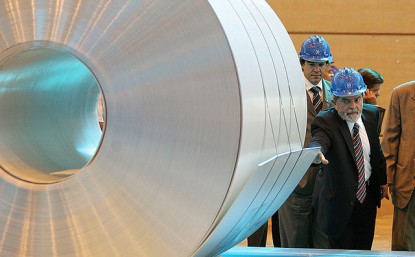
This year has seen a revival in aluminium prices along with prices for a number of other base metals, such as zinc and nickel. Whereas the strength in zinc and nickel prices has been mainly supply – driven, the picture for aluminium is more nuanced.
Aluminium is the second most produced metal in the world and is used in a wide range of applications, from construction and cars to packaging. The industry has been suffering from oversupply since 2007, mainly due to large capacity increases in China and the Middle East. Prices have been falling since 2011, leading to shutdown of smelters. These cuts in production have started to filter through to the markets and, since reaching a five-year low of 1,700 USD/tonne in February, prices quoted on the London Metal Exchange (LME) have been trending upwards.
Click here for reference chart.
Production cuts
It has been estimated that in the past few years, up to 5m tonnes of aluminium capacity has been shut, only 1m of which can be easily restarted. For comparison, world aluminium production in 2013 reached 50.6m tonnes. In 2014, the world’s biggest aluminium producers have announced production cuts. Russia’s Rusal cut its production by 8% in 2013 and by a further 12% y-o-y in Q1 2014 to the annual capacity of 883,000 tonnes. Alcoa, another major producer, cut its production to 551,000 tonnes in 2014. Over the last five years, Alcoa has permanently closed about 30% of its global aluminium smelting capacity.
These cuts have finally started to filter through to the market. World aluminium production during the period from January to June 2014 reached 30.1m tonnes, down 3% year-on-year. This was mainly driven by production declines in Europe (-5%) and North America (-8%), which more than offset increases in China (+8%) and the Middle East (+21%).
Falling stocks on the LME
Another factor often cited as a reason behind the recent strength in aluminium prices is falling stocks on the LME. Stocks at LME warehouses have fallen 13% this year, to two-year lows. However, they are still high by historical standards, at 4.7m tonnes. In addition, it is not clear to what extent this reduction reflects the underlying physical supply and demand in the market. There is speculation that this reduction was partly triggered by high storage costs in LME warehouses, and some of the metal leaving LME warehouses has been moving into cheaper non-bonded storage.
Concerns over feedstock supply
As with many other base metals, Indonesia’s ore export ban has been one of the factors driving prices for aluminium up in 2014. The ban, introduced in January 2014, prohibits the exports of unprocessed ores or minerals in their raw forms to encourage miners to process ores domestically before exporting. Indonesia accounts for over 60% of global exports of bauxite, a raw mineral used in the production of aluminium.
Is the strength in prices supported by demand?
At the same time, demand is strong in some key markets, notably from the automotive industry in the US. The transport industry is the largest end-use application for aluminium, accounting for one-quarter of global aluminium demand. In August, total car sales in the US rose to an annualised 17.5m vehicles, volumes not seen since before the recession, driven by an improving economy and falling fuel prices.
The picture is more mixed in Europe. Western European car sales rose to 640,123 in August, an increase of 1%, as weakening demand in Germany and France was offset by strong gains in the UK and Spain. However, the latest figures from China point at slowing demand growth. Sales of passenger cars in China rose to 1.47m vehicles in August, up 8.5% y-o-y, the weakest pace of expansion since March.
Outlook
So, on balance, it is likely that the aluminium market will remain strong over the next few months. However, several factors are making this outlook uncertain. The mentioned lack of clarity around the stocks situation is one factor. However, the major challenge for the sustainability of the recent rally in aluminium prices will be posed by developments in China.
China is responsible for over 40% of global aluminium production. Despite the oversupply that has persisted in the global market in recent years, production in China has been rising, as output in other major producing regions has fallen. In the four years to 2013, Chinese production grew 44% to 24.9m tonnes, with net exports steadily rising in recent years. However, not all the increase in production has been swallowed by exports and domestic consumption, and it is estimated that China will end the year with the largest excess supply in 14 years.
Economic growth in China has been slowing signs of slowing so far this year, with the latest data showing that China’s factory output, retail sales investment and imports all slowed in August, with factory output rising at the weakest pace in nearly six years. Should aluminium prices continue their rise, there is a substantial room for China to increase its exports which is likely to limit further increases in price.



 Follow us on Twitter
Follow us on Twitter Become our facebook fan
Become our facebook fan











Comments are closed.